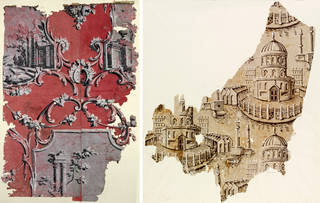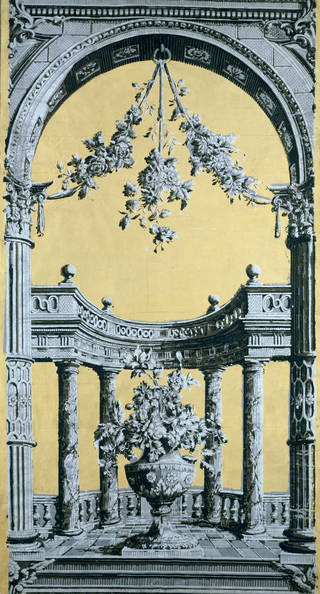Wallpapers imitating plasterwork first appeared in England from the late 17th century. Some of the early black and white papers seem to derive from plasterwork, particularly on ceilings. These were succeeded by simple patterns printed in 'grisaille' – a method of painting in grey monochrome, typically to imitate sculpture – and used on walls and ceilings where they convincingly imitated low-relief modelling in plaster or stucco.

The advantages of using paper decorations to imitate stucco and plaster were set out by the Eckhardt brothers of Chelsea, London, in a leaflet issued by the firm in May 1793: "Eating rooms already stuccoed might, at a small expense, receive additional embellishment". But rooms with bare walls could be given the same beauty and elegance of stuccoed interior, but without echo (a common complaint about such rooms) and without having to wait for the stucco to dry.
Architectural papers in a variety of styles were available from the mid-18th century, and continued to be popular until the mid-19th century. As well as elaborate renderings of sculpture, architectural features, and plasterwork, there were papers printed as trompe l'oeil imitations of masonry, marble, and later, brickwork, tiling and woodgrain.

There were two main styles of 'architecture papers': the Gothic and the classical, with occasional eccentric mixtures of the two. Amongst the earliest examples of Gothic wallpapers were those at Horace Walpole's house, Strawberry Hill, which was decorated throughout in the Gothic taste in the period 1753 – 76. In a letter to Lord Dover in 1753 Walpole describes this aspect of his decorations:
The bow window below leads into a little parlour hung with a stone-colour Gothick paper and Jackson's Venetian prints, which could never endure while they pretenced, infamous as they are, to be after Titian &c., but when I gave them the air of barbarous bas-reliefs they succeeded to a miracle;…From hence, under two gloomy arches you come to the hall and the staircase…Imagine the walls, covered with (I call it paper, but it is really paper painted in perspective to represent) Gothick fretwork.
The novelty and the fame of Walpole's decorations at Strawberry Hill gave an impetus to the Gothic revival style across Europe, and must have helped to create a market for Gothic wallpapers.
In due course, the Gothic style was both popularised and discredited. Complex and implausible patterns combining a miscellany of fanciful and inauthentic details were characteristic of the 'Gothick' style wallpapers from the 1820s onwards. Such papers, rather than imitating stone and stucco-work in low relief, were more obviously illusionistic and pictorial with vignettes of ruins, figures and landscapes, often printed in vivid colours. By the middle of the century such styles were appearing in machine-printed versions, designed to appeal to the lower end of the market. A typical example of these popular Gothic papers was hung in the Ostrich Hotel at Castleacre near Swaffham, Norfolk around 1820. At that time, the style was still popular, though hardly fashionable, but the paper may well have been chosen in part for its relevance to local sights and scenes, as Castleacre had a number of Gothic remains.

At a time when travellers were often interested in ruins and antiquities, a Gothic wallpaper would have been an apt choice of decoration for a hotel. This association of the Gothic style with hospitality seems to have been commonplace. In 1841 the architect and designer A.W.N. Pugin wrote dismissively of:
What are commonly termed Gothic pattern papers for hanging walls, where a wretched caricature of a pointed building is repeated from skirting to cornice, door over pinnacle and pinnacle over door.
He noted that there was 'a great variety of these miserable patterns', and that the style was 'a great favourite with hotel and tavern keepers'. Just as hoteliers in America favoured French scenic papers for their spectacular character and their obvious references to travel, so it seemed that Gothic style served a similar purpose for British innkeepers though at lesser cost and with rather more parochial associations.
The so-called 'pillar and arch' papers of the later 18th century employed both classical and Gothic features. Dramatic and handsome when considered in isolation, they appear rather disturbing when used to paper an entire room – the multiple vanishing points distorting the perspective. Generally it seems that papers of this kind were used for halls and staircases – tall narrow spaces where repetitive perspectives would have been less visible. An elaborate pattern of this kind, dated about 1760, with landscapes framed by 'Gothick' tracery and figures within a Gothic and classical framework, was found on the staircase of the Ancient High House in Stafford. It was pasted directly to the wattle and daub wall panels, with a ceiling paper representing low-relief plaster-work used on the structural timbers to frame the pictorial scenes of the main design.
These 'architecture papers' were popular with American customers. Advertisements placed by Thomas Lee in Boston newspapers in 1764 and 1765, included 'a fine Assortment of Gothic Paper Hangings' from London. As in England, such papers were mostly recommended for halls and staircases. Imposing 'pillar and arch' papers survive, or have been replaced in kind, in several New England houses, including Hamilton House, South Berwick, Maine, which had an American-made 'pillar and arch' paper of about 1787 in the entrance hall. The V&A has in its collection an elegant large-scale pattern of a similar type, but based on an English original of about 1769. The 'pillar and arch' formula was gradually elaborated to include figurative elements – often in the form of monuments and memorials.

In the 1840s and 1850s wallpaper panels were printed in 'grisaille' to represent sculptures. French manufacturers specialised in these grand decorations, but their subjects were often English, including representations of Queen Victoria and John Milton, as well as French royalty and allegorical figures. At the Great Exhibition of 1851, the wallpaper manufacturers Jeffrey & Co. exhibited a wallpaper frieze reproducing the Elgin Marbles. These were probably intended for public buildings such as town halls, and other civic buildings, and for places of public entertainment such as theatres.

Papers imitating marbling and woodgrain were produced throughout the 18th and 19th centuries and were popular for halls and passageways. As J. C. Loudon explained (in his Encyclopaedia, first published in 1833), for entrance lobbies and staircases one of the best designs was a paper "simply marked with lines in imitation of hewn stone" because if it was damaged, a piece the size of one of the stones could be renewed without the repair being obvious.

Despite these practical advantages such papers were frowned upon by the tastemakers of the later 19th century, because they objected to the sham of imitating one material in another.


